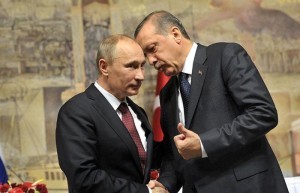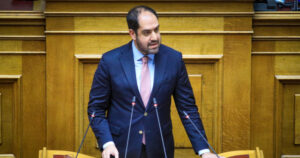The Atlantic Council released a very interesting analysis on the Russian-Turkish relation regarding Syria.
Turkish-Russian relations have been poor for years because of conflicting agendas in Syria. The Russian decision to intervene in late September 2015 directly challenged Turkish interests. At the outset of the Russian military operation, the goal appeared to be point defense of core regime areas, including the Latakia coast and the road to Damascus. Turkey, in contrast, worked for years to expand opposition held territory out to the coast, as part of its broader effort to empower the opposition to challenge the regime. This sub-set of the broader Turkish proxy war sparked a major escalation with Russia, and in so doing, contributed to the Turkish defeat in Syria.
This author undertook a study of Turkish, Kurdish, American, and Russian military actions in northern Aleppo between July 2014 and March 2017. The data suggested that counter escalation actions by Russian and Kurdish forces occurred when challenged by Turkey during operation Euphrates Shield, Turkey’s cross border military operation. Russia retains escalation dominance vis-a-vis Turkey and has a demonstrated track record of using the Afrin-based Syrian Kurdish YPG as a counter escalation tool to blunt Turkish efforts to regain leverage over Moscow. This dynamic has been a staple of the Syrian conflict after Russia’s direct military intervention.
For much of the Syrian civil conflict, the Turkish Air Force had been flying combat air patrols along the border, as part of an effort to deter regime air strikes along a narrow strip along the border. The Turkish effort intended to protect supply lines through Azaz to Aleppo through means of coercion and deterrence. Russia, starting in October 2015, directly challenged aspects of this policy. In an incident foreshadowing later developments, the Turkish air force downed a Russian Orlans-10 remotely piloted aircraft near the Kilis border in mid-October 2015. Just over a month later, on November 24, a Turkish F-16, most probably operating under relaxed rules of engagement and firing from beyond visual range, downed a Russian SU-24 bomber, after it strayed into Turkish airspace for 17 seconds. The incident took place in the Latakia mountains and long the likely route for Turkish backed forces to advance out to the coast.
The incident prompted Russia to focus on cutting Ankara off from Aleppo. This effort, according to Russia analyst Michael Kofman, is intended to help “shape the Syrian opposition on the ground, by eliminating those parts of it that it finds disagreeable at the negotiating table.” In late November, Russian expanded its strike areas to include the Azaz-Aleppo corridor. This bombing had three outcomes: 1) It grounded the Turkish Air Force, then conducting strike operations in the area, as part of the anti-ISIS coalition; 2) It upended US-Turkish planning to use trained rebels to close the Manbij pocket; 3) It culminated in the use of Russian air power and the YPG to knock Ankara out of northern Aleppo. These three interlinked objectives came together in early February 2016, wherein a span of 10 days, the Turkish link to Aleppo through Azaz was severed and the YPG moved out and took Minagh Air Force base and Tel Rifaat. It was only after Russia achieved these objectives that it agreed to a ceasefire on February 16, 2016.
The ceasefire allowed Turkey to reorient its actions in Syria towards the defeat of the Islamic State (ISIS, ISIL, Daesh). Turkish artillery, deployed along the border, began to shell ISIS positions, in support of the beleaguered Marea line rebels. Despite US support for this effort, the rebel groups were weak and divided, making them susceptible to ISIS counter attacks. The ‘ping-pong’ control over small and sparsely populated villages played out for months along the Turkish border, before the United States opted to use the Syrian Democratic Forces (SDF), a multi-ethnic military umbrella dominated by the Kurdish People’s Protection Units (YPG), to take Manbij. This offensive began in late May 2016, and by June, Manbij was besieged.
After the failed July 2016 coup, after which the Justice and Development Party (AKP) purged the internal opposition to it intervening in Syria, Ankara took steps to secure Russian acquiescence for what would later be dubbed operation Euphrates Shield. In late July, the Syrian regime besieged Aleppo, with assistance from Russian advisers and air power. Turkey and the United States engaged in negotiations with Moscow to evacuate Eastern Aleppo, but it was Turkey that finalized the arrangement. On August 9, Presidents Erdogan and Putin met in St. Petersburg, where, in retrospect, it appears that the two agreed to a deconfliction arrangement to allow for the forthcoming Turkish invasion. Five days later, on August 14, Manbij fell to the SDF, prompting concerns in Ankara that the group would expand to Jarablus and al-Bab, the latter of which would then allow for the connecting of Kurdish territory along the Turkish-Syrian border.
On August 24, the Turkish military moved across the border, facing little resistance. The operation was derisively labeled as Turkey trading Aleppo for al-Bab. This portrayal, however, fails to account for Russian efforts throughout the campaign to ensure that Ankara did not threaten its core interests in Aleppo. Moscow also continued with its strategy of using the YPG as a counter-escalation tool against Turkey. This first incident took place in mid-October, when Turkish military forces and its allied proxies clashed with the YPG south of Tel Rifaat, some 25 kilometers west of al-Bab. Then, on November 24, an Iranian drone, most probably flying in support of the Syrian Armed Forces or an allied militia, struck Turkish forces, killing three. A day later, Presidents Erdogan and Putin spoke on the telephone, and Foreign Minister Mevlut Cavusolgu visited Tehran on November 26. The fighting in the area de-escalated the day of the Putin-Erdogan phone call and, shortly thereafter, a small Kurdish militia allied with the Syrian regime linked up with the SDF in the area to act as a buffer force.
A similar dynamic took place in Manbij, in February 2017. After the fall of al-Bab in mid-November, Turkish allied forces began to attack SDF held positions west of al-Arima. The previous month, Ankara had sought to prevent the town from falling to the SDF, but because the allied militias that fought alongside Turkey were weak, they were unable to fight on multiple fronts at once. Turkish artillery, used to offset the weaknesses of its allied ground forces, was unable to prevent the town from falling. After al-Bab fell to Turkish backed forces in late February, Turkish backed forces attacked SDF positions west of al-Arima. In the ensuing clashes, SDF elements lost control over a few villages. This prompted the SDF to counter-escalate. On March 1, Russia, the regime, and the SDF reached an agreement to form a small, jointly enforced ribbon around the western edge of SDF held territory.
At the outset of this arrangement, the tactics mimicked those south of Tel Rifaat, where SDF and regime allied militias simply co-located, perhaps with some SDF elements simply wearing Syrian regime uniforms. Russia re-escalated its involvement in the area on March 8, one day after Turkey convened a trilateral meeting with Moscow and Washington. On March 9, President Erdogan travelled to Moscow for a two-day summit. Upon his return to Ankara, on March 10, all the clashes had stopped in Turkish controlled territory with Syria. Up to that point, Ankara had repeatedly used artillery to strike Tel Rifaat, Minagh Air Force Base, and Manbij, most likely to soften YPG and SDF defensives for an expansion of its military offensive.
The trilateral summit and the Moscow visit went poorly for Turkey. Turkey’s continued challenge along the western outskirts of al-Arima prompted Russia to deepen its footprint in the area, an outcome that ultimately ended the fighting. Moreover, the Russian government kept some of the economic sanctions levied in December 2015 after the SU-24 bombing in place. It appears that Turkey imposed retaliatory sanctions against Russia on March 16, 2017, imposing a tariff on Russian wheat imports. Ankara denies that this amounts to an official sanction, but up until mid-March, Russia had been importing wheat duty free.
Finally, on March 20, the Russian military announced that it was setting up a military area in YPG-held Afrin to monitor a cease-fire brokered with Turkey, in Astana, months earlier. The ceasefire has not held, but the Russian framing of the arrangement—and concurrent announcement of forces in the area—is at odds with Ankara’s long-standing portrayal that it has the right to target the YPG because Turkey lists them as a terrorist group. The outcome of this latest Russian move has boxed Turkey in northern Aleppo.
The sequence of events clearly demonstrates how Russia is working at cross-purposes with Ankara in Syria, and how Russia and the YPG have a mutually beneficial relationship in countering Turkey in Syria. Turkey still has means to put pressure on Russia in Syria. Ankara is training rebels in Turkey to join its proxies in northern Aleppo. Turkey could simply send these to other areas in Idlib or down to Hama to attack regime positions. However, the events between November 2015 and February 2017 clearly shows that Russia has escalation dominance in Syria vis-a-vis Turkey. Moreover, the YPG in Afrin—well armed and now with overt Russian assistance—could move south to take the Reyhanli / Bab al-Hawa border crossing. Russia could easily justify such action as necessary to defeat Syria’s al-Qaeda affiliate, which has a strong presence in Idlib. To stop them, Ankara would have to risk targeting Russian soldiers, risking a broader clash, wherein Turkey is the weaker of the two parties.
Yet, for Turkey, Russia remains a valuable tool to try and put pressure on the United States. Ankara rejects US support for the SDF, as it also empowers the YPG along the northeastern border. Turkey has sought to use Moscow to signal to the United States that it has options, beyond the US-Turkish alliance and, by extension, Turkish reliance on NATO for its security. The events in Syria clearly contradict this. Russia is not an ally of Turkey. Instead, Russia is using all the means at its disposal to shape the opposition to serves its end goals of a negotiated settlement on its own terms—goals at odds with Turkish interests. Turkey has few options to alter this dynamic, especially since the United States is pushing ahead with its preferred partner in northeastern Syria, the SDF. Turkey has even fewer options to stop the trajectory of these two larger powers.
Ask me anything
Explore related questions





